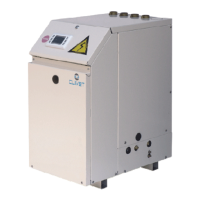Do you have a question about the CLIVET WSHN-XEE2 10.2 and is the answer not in the manual?
Highlights potential risks and emphasizes careful reading of residual risks.
Details requirements for outdoor installation, system design, and electrical compliance.
Advises on planned periodic inspection and maintenance for cost reduction.
Instructs to disable the unit immediately and contact a service agent.
Provides step-by-step guidance on safely handling the unit during transport and installation.
Lists criteria for selecting the installation place, including access and technical spaces.
Specifies required water features and acceptable values to prevent unit damage.
Details the process for making hydraulic connections, including welding and joints.
Explains the function of the flow switch and installation requirements to ensure unit shutdown.
Provides a step-by-step guide for electrical connections, ensuring safety and compliance.
Details how to connect a PC for configuration and operation, including network settings.
Explains the options and connection methods for remote control units.
Provides a detailed step-by-step sequence for starting up the unit after installation.
Details the ECOSHARE function for managing multiple units in a local network, including topology and modes.
Provides steps to modify the setpoint for cooling, heating, and other modes.
Describes how to set up events (Off, Eco, On, Recirculating) for each day of the week.
Explains how to identify, display, and reset alarms, emphasizing caution with repeated resets.
Recommends inspection frequency and lists items to check during inspections.
Emphasizes the importance of keeping the water side exchanger clean and describes how to clean it.
Details the procedure for system discharge, including evacuation and flushing the exchanger.
Describes the Natural Cooling function, its installation requirements, and operational conditions.
Guides on sending the unit to authorized centers for dismantling and disposal, and material recovery.
Details risks associated with electric parts, including shocks, fires, and improper earthing.
Discusses risks related to refrigerant, including expulsion, intoxication, and explosion hazards.
Lists calibrations for various control devices like pressure switches and safety valves.
Highlights potential risks and emphasizes careful reading of residual risks.
Details requirements for outdoor installation, system design, and electrical compliance.
Advises on planned periodic inspection and maintenance for cost reduction.
Instructs to disable the unit immediately and contact a service agent.
Provides step-by-step guidance on safely handling the unit during transport and installation.
Lists criteria for selecting the installation place, including access and technical spaces.
Specifies required water features and acceptable values to prevent unit damage.
Details the process for making hydraulic connections, including welding and joints.
Explains the function of the flow switch and installation requirements to ensure unit shutdown.
Provides a step-by-step guide for electrical connections, ensuring safety and compliance.
Details how to connect a PC for configuration and operation, including network settings.
Explains the options and connection methods for remote control units.
Provides a detailed step-by-step sequence for starting up the unit after installation.
Details the ECOSHARE function for managing multiple units in a local network, including topology and modes.
Provides steps to modify the setpoint for cooling, heating, and other modes.
Describes how to set up events (Off, Eco, On, Recirculating) for each day of the week.
Explains how to identify, display, and reset alarms, emphasizing caution with repeated resets.
Recommends inspection frequency and lists items to check during inspections.
Emphasizes the importance of keeping the water side exchanger clean and describes how to clean it.
Details the procedure for system discharge, including evacuation and flushing the exchanger.
Describes the Natural Cooling function, its installation requirements, and operational conditions.
Guides on sending the unit to authorized centers for dismantling and disposal, and material recovery.
Details risks associated with electric parts, including shocks, fires, and improper earthing.
Discusses risks related to refrigerant, including expulsion, intoxication, and explosion hazards.
Lists calibrations for various control devices like pressure switches and safety valves.











